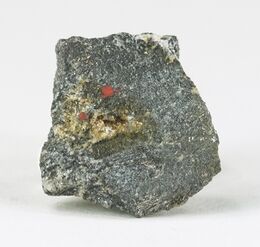Chemistry:Bukovite
From HandWiki
| Bukovite | |
|---|---|
 Bukovite: metallic grayish-brown grains are noted by the two red dots | |
| General | |
| Category | Selenide – Bukovite group |
| Formula (repeating unit) | Tl2(CuFe)4Se4 |
| Strunz classification | 2.BD.30 |
| Dana classification | 2.5.5.2 |
| Crystal system | Tetragonal |
| Crystal class | Ditetragonal dipyramidal (4/mmm) H-M symbol: (4/m 2/m 2/m) |
| Space group | I4/mmm |
| Unit cell | V = 216.58 Å3 |
| Identification | |
| Color | Grayish-brown |
| Cleavage | Distinct/good: Good on {001} imperfect on {100} |
| Mohs scale hardness | 2 |
| |re|er}} | Metallic |
| Diaphaneity | Opaque |
| Specific gravity | 7.40 (calculated) |
| References | [1][2] |
Bukovite is a rare selenide mineral with formula Tl2Cu3FeSe4. It is a brown to black metallic mineral which crystallizes in the tetragonal system.[1]
It was first described in 1971 for an occurrence in the Bukov uranium mine, Rožná deposit, Vysočina Region, Moravia, Czech Republic.[2] It has also been reported in Skrikerum, near Tryserum, Kalmar, Sweden; near Vernet-la-Varenne, Puy-de-Dôme, France ; and Tuminico, Sierra de Cacho, La Rioja Province, Argentina .[1]
See also
References
- ↑ 1.0 1.1 1.2 Handbook of Mineralogy
- ↑ 2.0 2.1 http://www.mindat.org/min-797.html Mindat
- ↑ Warr, L.N. (2021). "IMA–CNMNC approved mineral symbols". Mineralogical Magazine 85 (3): 291–320. doi:10.1180/mgm.2021.43. Bibcode: 2021MinM...85..291W.
 |

